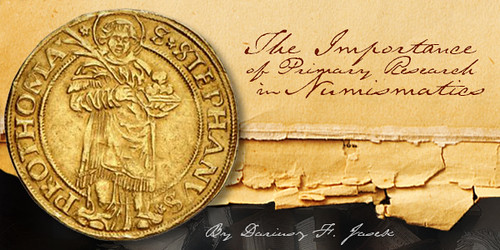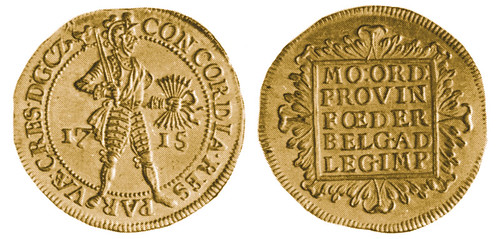
PREV ARTICLE
NEXT ARTICLE
FULL ISSUE
PREV FULL ISSUE
PRIMARY RESEARCH AND THE NETHERLANDS DUCATAn article by Dariusz F. Jasek published in CoinWeek March 15, 2017 emphasizes the importance of primary research in numismatics as illustrated by the history of the
Netherlands gold ducat. here's an excerpt. -Editor
 In the beginning of my research on gold ducats I looked for the existing literature on the subject. André Delmonte’s well-known book entitled Le Benelux D’Or and Albert Scheffers’ The Dutch Gold Ducat (1586-1986) were my first choices. Shortly afterwards I searched for more new and old books. The more that I read, the more I noticed that there were inconsistencies and direct contradictions within the different books and it was rather obvious that somebody had to be wrong. Given that, I soon realized that doing my own primary research would be the only way I could find true answers to my questions. Modern Books
Delmonte also listed some fancy coin types, like the Nijmegen double ducat with St. Stephanus kneeling. This specific coin seems to have been completely misidentified and is instead a Nijmegen undated double ducat with St. Stephanus standing; because the only known specimen, which was supposed to be found in the Vienna Coin Cabinet, was in fact never there. The reference to the Vienna Collection was reported by Delmonte and then duplicated by other authors in their own works, but I received confirmation directly from the Kunsthistorisches Museum that this reference is incorrect. The only publication specifically about The Netherlands gold ducats--a red booklet published in 1986 by Albert Scheffers on the 400th anniversary of introducing this coin type--is a very good book. In the listing of dates when gold ducats were minted, however, Scheffers made a number of mistakes. Looking further for modern Dutch books on the provincial coinage I found two of the leading coin catalogs in The Netherlands today: “Catalogus van de Nederlandse munten” by Jan C. van der Wis and Tom Passon, and a two-volume set entitled “Handboek van de Nederlandse Provinciale Muntslag” by Dick Purmer. Both are very good books on the subject, and of equal importance. But sometimes they contradict each other. For example, when it comes to the Gelderland 1715 double ducat, according to one author (Purmer) it was supposed to have been minted with a mintmaster’s privy mark (a crane). Yet according to the other authors (Passon & van der Wis) it was minted without this privy mark. Therefore, I contacted the Norwegian Museum in Oslo, where the only known example of this date can be found. Looking at the coin was the only way to judge which book description was correct. 
The Gelderland 1715 double ducat To read the complete article, see:
 Wayne Homren, Editor The Numismatic Bibliomania Society is a non-profit organization promoting numismatic literature. See our web site at coinbooks.org. To submit items for publication in The E-Sylum, write to the Editor at this address: whomren@gmail.com To subscribe go to: https://my.binhost.com/lists/listinfo/esylum All Rights Reserved. NBS Home Page Contact the NBS webmaster 
|